industrious95
Contributor
[TABLE="width: 800"]
[TR]
[TD]This story is about one of my most memorable dives.
I grew up in the 1960’s, and fell in love with the sea watching a television show called “Flipper.” Since I was 5 years old, I wanted to be like the kids in that show, strapping a tank to their back and jumping into the ocean.
As I grew up, the family used to spend the weekends at the Jersey shore, where I learned to snorkel. Well, I shouldn't say I learned. I just put the mask and snorkel and fins on and went into the ocean. Me and Miss Atlantic were inseparable during the summer. My mother thought I must have had gills.
One thing that many New Jersey divers have in common is our love of fresh seafood. Regardless if you’re a fan of shipwrecks, an underwater photographer, videographer, archaeologist or if you just like looking at the fish, sooner or later you’re going to find yourself on a dive boat populated with divers with game bags.[/TD]
[/TR]
[/TABLE]
[TABLE="width: 800, align: left"]
[TR]
[TD]The date was August 23. 2003. The boat I was on, the Outlaw, was a well know dive boat based out of Belmar, NJ. I had befriended a group of divers that liked to take off from work on Mondays to get a little nitrogen fix in their bloodstreams. For the nitrox divers in the group, the note for this Monday’s trip was “bring gas good to 130 feet.”
Captain Bob Nash met us all at the dock and made his typical snide remarks as we loaded our tanks, 3 per diver, onto his 60 ft twin diesel wooden boat. The chatter that day, aside from the typical insults and jokes, was that we were going for scallops.[/TD]
[TD]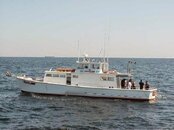 [/TD]
[/TD]
[/TR]
[/TABLE]
[TABLE="width: 800"]
[TR]
[TD]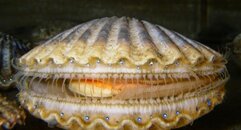 [/TD]
[/TD]
[TD]Scallops are a strange creature. Unlike most mollusks, scallops swim. If you have ever seen one in the water, it’s really amazing to watch. Scallops have rows of “eyes” around the opening of their shells. When they see something that resembles a threat, they scoot away like little jet propelled soap dishes.[/TD]
[/TR]
[/TABLE]
[TABLE="width: 800"]
[TR]
[TD]Unfortunately for the little guys, they don’t have very good eyes. They can see light and motion, but not shapes. An alert diver can quickly learn to collect them before they take off.
It was a 90 minute ride to our destination. Captain Bob wouldn’t reveal where we were, just that we were likely to find scallops. When we reached the spot, he gave us a quick briefing.[/TD]
[TD]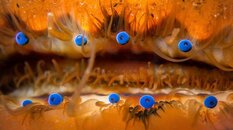 [/TD]
[/TD]
[/TR]
[/TABLE]
[TABLE="width: 800"]
[TR]
[TD] "Depth 120 feet. Some structure on the bottom but nothing that looks like a shipwreck. Watch your bottom time, watch your ascent rate, be careful and have a good time. Now get the hell off my boat."
Because the water was so calm, the decision was made to drop two groups of divers each into two different locations about 1000 feet apart. As he dropped the first group of four divers into the ocean, he said “Swim west.”
I was in the second group. The plan was that after Captain Bob dropped off the second group, he would go back to the first group to pick them up, then return for us. It’s what’s called a “Buoy Dive” in New Jersey.
As Captain Bob slowly moved the boat into position, he nodded from the wheelhouse to the mate, who dropped a home made buoy into the water. Captain Bob’s buoy’s were old plastic bleach containers, wrapped with the appropriate length of wreck reel line for the depth, with an old window sash weight at the end of the line.
With the buoy deployed, we three divers lined up to hop overboard. The Captain called down to us from the wheelhouse. “When you get to the bottom, swim east.” We waved our acknowledgement to him and he maneuvered the Outlaw into position. One – two – three. We all rolled over the side of the boat into the water.
I was the first to go. As soon as I spotted the buoy line, I dumped the air from my BC, pointed downwards and kicked my way to the bottom as quick as I could clear my ears.
As I reached the bottom, my computer indicated 118 feet and I saw a scallop right next to the sash weight. I plucked him up - his shell was at least 5 inches across, and opened my game bag and dropped him in. Looking in front of me, I saw another scallop about 3 feet away. I swam up to him and he sputtered away, but I quickly grabbed him. Then I saw another scallop about 3 feet away.
I continued following what seemed like an endless line of scallops for about ten minutes, leaving the smaller guys on the bottom while quickly filling my game bag. As this was before I bought my steel tanks, I was using an Aluminum 80, and it was soon time to go.
I tried finning off the bottom to start my ascent, but my game bag weighed quite a bit with all those scallops and their shells in it. I secured the game bag closed and attached my lift bag to it. Since this was going to be a free ascent, I decided to send the lift bag up on the end of my wreck reel, which I would then use to ascend, winding in the line as I went.
I fed the lift bag a bit of air until it started to rise, then watched it go up out of sight. When my wreck reel stopped unraveling, I knew it had reached the surface and started to fin my way off the bottom. This time I rose with no problem.
I ascended slowly, watching my bubbles and breathing steadily. I stopped off at 60 feet for a minute, then continued up to 20 feet, continuously winding in my line. At 35 feet, I could see my lift bag on the surface. At 20 feet, I let a little more air out of my BC to stop my ascent, and hung in the water, watching my depth, my air pressure gauge and my bag of scallops floating above me.
When I finally broke the surface, I could see I was the first diver up from my group. The Outlaw was still picking up the other divers, so I just enjoyed floating on the calm ocean, lightly bobbing up and down thinking about how lucky I was to be able to take such a beautiful day off from work. I watched the boat and got a wave from the Captain; I touched my head with the "okay" sign.
After a few more minutes, two other heads popped up, the closest about 150 feet away. We waved to each other and waited patiently.
When the boat came to pick me up, Captain Bob leaned over the side of the boat and grabbed the top of my lift bag. He tried to pick it up, but it was too heavy and he didn’t have enough leverage to lift it. He quickly retrieved a hook, and carefully slid it around the rope and twisted it. As the mate leaned in to help, the two of them lifted my bag of scallops onto the boat and their eyes opened wide. My game bag was 4 feet long, 3 feet wide, and was bulging with scallops.
Seeing the scallops in the boat, he told me to let go of my wreck reel so he could pull it in. I un-clipped it from my BC, tightened it so it wouldn't unwind, and released it. Climbing into the boat, I asked the other divers “How’d everyone do?” There were about 35 scallops among the other four divers in the boat.
As the last diver from my group climbed aboard, he needed no help bringing his scallops on. He had 10.
“We went East like you told us to,” they all complained to the Captain. “Where did Dave get so many scallops from?”
“I never looked at my compass,” I laughed. “I just followed the trail and threw them into my bag.”
Just as an aside to my story, I wouldn't want anyone to think I’m bragging about my underwater hunting abilities, because I’m usually the diver who comes back empty handed. I have been on the boat many times when every diver had 4 or 5 lobsters and I had to stop at the fish market on the ride home so as not to disappoint my wife. This was just my lucky day.[/TD]
[/TR]
[/TABLE]
[TABLE="width: 800"]
[TR]
[TD]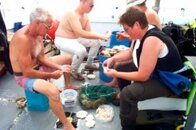 [/TD]
[/TD]
[TD]We sat around the back of the boat shucking the scallops, enjoying a little scallop Sushi, and joking about how the Captain didn’t know East from West. The abductor muscle, the part you eat, on the scallops that we harvested were on average about 2 inches across and an inch thick. Some were even larger. There were a few that were close to 4 inches across. You truly could make a filling meal on just 3 or 4 of them. So I shared my luck with the other divers on the boat and everyone went home with dinner for two that night.[/TD]
[/TR]
[/TABLE]
[TABLE="width: 800"]
[TR]
[TD]Except for me, I kept the extras – bringing home about 4 pounds of scallop meat.
Fresh scallops have the most incredible taste you can imagine. I love all kinds of fresh seafood, but I think the scallop is the best of them all.
A quick credit - scallop images were taken from Wikipedia and are shared here as per their Creative Commons license. The photo of the Outlaw and shucking scallops were taken by dive buddies. When they see this post and complain I haven't credited them properly, I will update this post.[/TD]
[TD]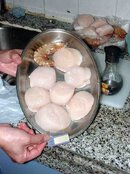 [/TD]
[/TD]
[/TR]
[/TABLE]
[TR]
[TD]This story is about one of my most memorable dives.
I grew up in the 1960’s, and fell in love with the sea watching a television show called “Flipper.” Since I was 5 years old, I wanted to be like the kids in that show, strapping a tank to their back and jumping into the ocean.
As I grew up, the family used to spend the weekends at the Jersey shore, where I learned to snorkel. Well, I shouldn't say I learned. I just put the mask and snorkel and fins on and went into the ocean. Me and Miss Atlantic were inseparable during the summer. My mother thought I must have had gills.
One thing that many New Jersey divers have in common is our love of fresh seafood. Regardless if you’re a fan of shipwrecks, an underwater photographer, videographer, archaeologist or if you just like looking at the fish, sooner or later you’re going to find yourself on a dive boat populated with divers with game bags.[/TD]
[/TR]
[/TABLE]
[TABLE="width: 800, align: left"]
[TR]
[TD]The date was August 23. 2003. The boat I was on, the Outlaw, was a well know dive boat based out of Belmar, NJ. I had befriended a group of divers that liked to take off from work on Mondays to get a little nitrogen fix in their bloodstreams. For the nitrox divers in the group, the note for this Monday’s trip was “bring gas good to 130 feet.”
Captain Bob Nash met us all at the dock and made his typical snide remarks as we loaded our tanks, 3 per diver, onto his 60 ft twin diesel wooden boat. The chatter that day, aside from the typical insults and jokes, was that we were going for scallops.[/TD]
[TD]
 [/TD]
[/TD][/TR]
[/TABLE]
[TABLE="width: 800"]
[TR]
[TD]
 [/TD]
[/TD][TD]Scallops are a strange creature. Unlike most mollusks, scallops swim. If you have ever seen one in the water, it’s really amazing to watch. Scallops have rows of “eyes” around the opening of their shells. When they see something that resembles a threat, they scoot away like little jet propelled soap dishes.[/TD]
[/TR]
[/TABLE]
[TABLE="width: 800"]
[TR]
[TD]Unfortunately for the little guys, they don’t have very good eyes. They can see light and motion, but not shapes. An alert diver can quickly learn to collect them before they take off.
It was a 90 minute ride to our destination. Captain Bob wouldn’t reveal where we were, just that we were likely to find scallops. When we reached the spot, he gave us a quick briefing.[/TD]
[TD]
 [/TD]
[/TD][/TR]
[/TABLE]
[TABLE="width: 800"]
[TR]
[TD] "Depth 120 feet. Some structure on the bottom but nothing that looks like a shipwreck. Watch your bottom time, watch your ascent rate, be careful and have a good time. Now get the hell off my boat."
Because the water was so calm, the decision was made to drop two groups of divers each into two different locations about 1000 feet apart. As he dropped the first group of four divers into the ocean, he said “Swim west.”
I was in the second group. The plan was that after Captain Bob dropped off the second group, he would go back to the first group to pick them up, then return for us. It’s what’s called a “Buoy Dive” in New Jersey.
As Captain Bob slowly moved the boat into position, he nodded from the wheelhouse to the mate, who dropped a home made buoy into the water. Captain Bob’s buoy’s were old plastic bleach containers, wrapped with the appropriate length of wreck reel line for the depth, with an old window sash weight at the end of the line.
With the buoy deployed, we three divers lined up to hop overboard. The Captain called down to us from the wheelhouse. “When you get to the bottom, swim east.” We waved our acknowledgement to him and he maneuvered the Outlaw into position. One – two – three. We all rolled over the side of the boat into the water.
I was the first to go. As soon as I spotted the buoy line, I dumped the air from my BC, pointed downwards and kicked my way to the bottom as quick as I could clear my ears.
As I reached the bottom, my computer indicated 118 feet and I saw a scallop right next to the sash weight. I plucked him up - his shell was at least 5 inches across, and opened my game bag and dropped him in. Looking in front of me, I saw another scallop about 3 feet away. I swam up to him and he sputtered away, but I quickly grabbed him. Then I saw another scallop about 3 feet away.
I continued following what seemed like an endless line of scallops for about ten minutes, leaving the smaller guys on the bottom while quickly filling my game bag. As this was before I bought my steel tanks, I was using an Aluminum 80, and it was soon time to go.
I tried finning off the bottom to start my ascent, but my game bag weighed quite a bit with all those scallops and their shells in it. I secured the game bag closed and attached my lift bag to it. Since this was going to be a free ascent, I decided to send the lift bag up on the end of my wreck reel, which I would then use to ascend, winding in the line as I went.
I fed the lift bag a bit of air until it started to rise, then watched it go up out of sight. When my wreck reel stopped unraveling, I knew it had reached the surface and started to fin my way off the bottom. This time I rose with no problem.
I ascended slowly, watching my bubbles and breathing steadily. I stopped off at 60 feet for a minute, then continued up to 20 feet, continuously winding in my line. At 35 feet, I could see my lift bag on the surface. At 20 feet, I let a little more air out of my BC to stop my ascent, and hung in the water, watching my depth, my air pressure gauge and my bag of scallops floating above me.
When I finally broke the surface, I could see I was the first diver up from my group. The Outlaw was still picking up the other divers, so I just enjoyed floating on the calm ocean, lightly bobbing up and down thinking about how lucky I was to be able to take such a beautiful day off from work. I watched the boat and got a wave from the Captain; I touched my head with the "okay" sign.
After a few more minutes, two other heads popped up, the closest about 150 feet away. We waved to each other and waited patiently.
When the boat came to pick me up, Captain Bob leaned over the side of the boat and grabbed the top of my lift bag. He tried to pick it up, but it was too heavy and he didn’t have enough leverage to lift it. He quickly retrieved a hook, and carefully slid it around the rope and twisted it. As the mate leaned in to help, the two of them lifted my bag of scallops onto the boat and their eyes opened wide. My game bag was 4 feet long, 3 feet wide, and was bulging with scallops.
Seeing the scallops in the boat, he told me to let go of my wreck reel so he could pull it in. I un-clipped it from my BC, tightened it so it wouldn't unwind, and released it. Climbing into the boat, I asked the other divers “How’d everyone do?” There were about 35 scallops among the other four divers in the boat.
As the last diver from my group climbed aboard, he needed no help bringing his scallops on. He had 10.
“We went East like you told us to,” they all complained to the Captain. “Where did Dave get so many scallops from?”
“I never looked at my compass,” I laughed. “I just followed the trail and threw them into my bag.”
Just as an aside to my story, I wouldn't want anyone to think I’m bragging about my underwater hunting abilities, because I’m usually the diver who comes back empty handed. I have been on the boat many times when every diver had 4 or 5 lobsters and I had to stop at the fish market on the ride home so as not to disappoint my wife. This was just my lucky day.[/TD]
[/TR]
[/TABLE]
[TABLE="width: 800"]
[TR]
[TD]
 [/TD]
[/TD][TD]We sat around the back of the boat shucking the scallops, enjoying a little scallop Sushi, and joking about how the Captain didn’t know East from West. The abductor muscle, the part you eat, on the scallops that we harvested were on average about 2 inches across and an inch thick. Some were even larger. There were a few that were close to 4 inches across. You truly could make a filling meal on just 3 or 4 of them. So I shared my luck with the other divers on the boat and everyone went home with dinner for two that night.[/TD]
[/TR]
[/TABLE]
[TABLE="width: 800"]
[TR]
[TD]Except for me, I kept the extras – bringing home about 4 pounds of scallop meat.
Fresh scallops have the most incredible taste you can imagine. I love all kinds of fresh seafood, but I think the scallop is the best of them all.
A quick credit - scallop images were taken from Wikipedia and are shared here as per their Creative Commons license. The photo of the Outlaw and shucking scallops were taken by dive buddies. When they see this post and complain I haven't credited them properly, I will update this post.[/TD]
[TD]
 [/TD]
[/TD][/TR]
[/TABLE]



